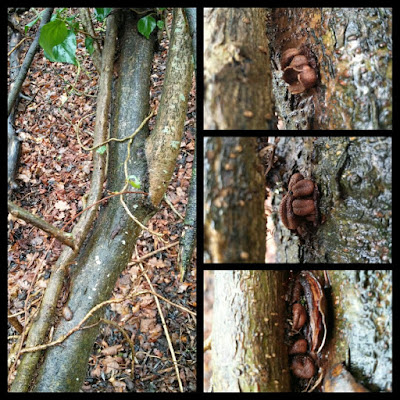I headed out to Horton Wood in the drizzle yesterday: perfect weather for funguses!
On a fallen trunk, I found masses of this: an Ascocoryne species in its asexual 'anamorphic' stage.
I found a 'Key to Ascocoryne' on AscoFrance.com, here (Baral 2000) but it seems to require observation of the ascospores which I think are only present in the sexual 'teleomorphic' stage.
I've had a quick look under the microscope and all I can see is a tangled mass of hyphae and these tiny sausage-shaped things which I think are conidia.
They look right for A. sarcoides, based on images on the first-nature.com website (here) but I don't know if that's enough to confirm an identification.
UPDATE 10/02/2018 - Feedback from Nick Aplin over on the Sussex Fungus Group Yahoo! discussion group: "Yeah, that's the anamorph of Ascocoryne sarcoides. A. cylichnium doesn't have a (known) anamorph, A.inflata has a pale bubbly looking thing and A.solitaria has white blobs with dark stalks. They're all ID-able in the field providing the material is good enough. Conversely, the teleomorphs aren't necessarily ID-able in the field."
Nice to be able to confirm this one as Purple Jellydisc A. sarcoides.
Pretty sure these are young fruit-bodies of Turkeytail Trametes versicolor; the pores underneath looked right for that species.
Fresh young Jelly Ear Auricularia auricula-judae were fruiting in several places; not just on Elder but also on other fallen deadwood (Ash?).
I spotted my first Spring Hazelcup Encoelia furfuracea of the year, growing on hazel and wedged up against an ivy stem; it was growing in at least three separate places along the length of the ivy, making me wonder what the connection is here between the fungus the ivy. Perhaps it just likes the sheltered microclimate?
I went on to find Spring Hazelcup Encoelia furfuracea on a few different stands of hazel around Horton Wood; as I did last year. I have submitted record details to the FRDBI so I can continue to keep track of the Small Dole Spring Hazelcup Encoelia furfuracea population.
I found a couple jelly fungi which I'm assuming are Exidia species. The first of which I think may be Exidia plana?
 |
| Growing on trunk of living hazel. |
 |
| Growing on fallen branch. |
Anyway, here's what the basidia look like. Do they look stalked to you?
And here are some other bits. I think the sausage-shaped things are spores.
UPDATE 10/02/2018 - Managed to get a second opinion on whether these basidia are 'stalked'. Nick Aplin has responded to say, "I think you have Exidia nucleata. For me the basidia do have stalks (with clamps at the base of the stalk not at the base of the basidium) ... I've stuck some arrows and notes to your images which might (?) make things clearer. I reckon E.thuretiana tends to be a bit more cloudy and resupinate-like, but others might disagree. Shame there's not much reliable info on these species on the web."
 |
| Thanks to Nick Aplin for the annotations. I can totally see the clamp! |
Having spent ages last weekend trying to find some D. stillatus spores, without success (here), I reluctantly tried again with this specimen. This time I spotted the spores instantly and found they show the four compartments separated by cell walls ('septa') nicely. These spores are also the right size for D. stillatus, being around 17 microns long by 6 microns wide. So I think I can confirm the ID this time.
And having spent quite a bit of time recently looking at the different Yellow Brain Tremella species, I'd be inclined to call this one Tremella mesenterica.
There were some interesting resupinate fungi around too.
I think this is Bleeding Oak Crust Stereum rugosum on the fallen oak.
In these damp conditions you can see how, when you cut it, it bleeds.
I found lots of Silverleaf Fungus Chondrostereum purpureum on an old willow.
This – on a fallen oak branch (?) – looked very interesting, but fairly well rotted, so I didn't take a specimen. It came away from the substrate in patches when touched.
I'd be interested to know if anyone's got any ideas on what this could be.
References
Baral, H.O., 2000, 'Key to Ascocoryne', www.ascofrance.com, URL: www.ascofrance.com/uploads/forum_file/5598.doc
Roberts, P., 2001, 'A Key to the British Exidia Species', Field Mycology, Vol 2(4), URL: https://doi.org/10.1016/S1468-1641(10)60535-X
For the record
Date: 20/01/2018
Location: Horton Wood, Small Dole
Grid reference: TQ208127 (site centroid)
Records entered into FRDBI 07/09/2018
















No comments:
Post a Comment